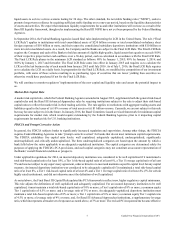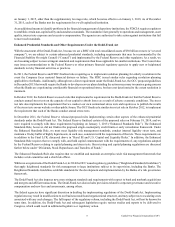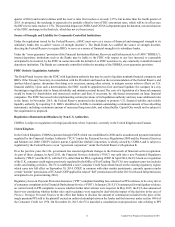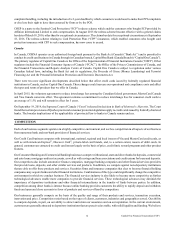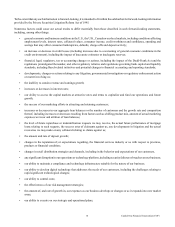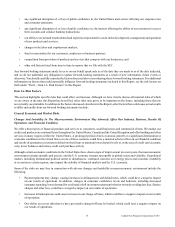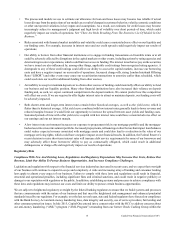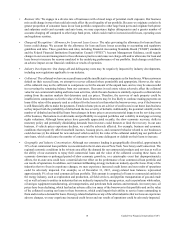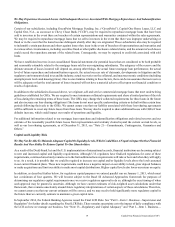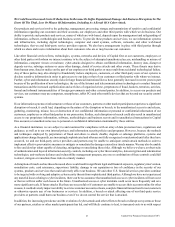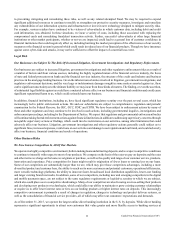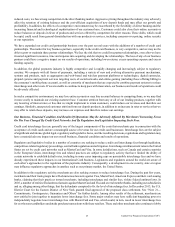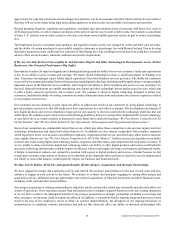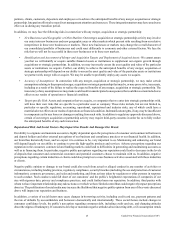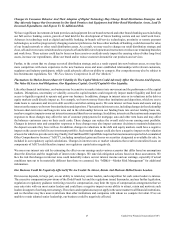Capital One 2015 Annual Report Download - page 36
Download and view the complete annual report
Please find page 36 of the 2015 Capital One annual report below. You can navigate through the pages in the report by either clicking on the pages listed below, or by using the keyword search tool below to find specific information within the annual report.17 Capital One Financial Corporation (COF)
Commercial Banking business. We have made substantial progress in taking the steps and making the improvements required by
the OCC consent order. We expect heightened oversight of our AML Program will continue for the foreseeable future.
The Dodd-Frank Act, other regulatory reforms and implementing regulations have increased our need to build new compliance
processes and infrastructure and to otherwise enhance our risk management throughout all aspects of our business. The cumulative
impact of these changes also includes higher expectations for the amount of capital and liquidity we must maintain, as discussed
in more detail below under the heading “We May Not Be Able To Maintain Adequate Capital Or Liquidity Levels, Which Could
Have A Negative Impact On Our Financial Results And Our Ability To Return Capital To Our Shareholders,” and higher operational
costs, which may further increase as regulators continue to implement such reforms. U.S. government agencies charged with
adopting and interpreting laws, rules and regulations, including under the Dodd-Frank Act, may do so in an unforeseen manner,
including in ways that potentially expand the reach of the laws, rules or regulations more than initially contemplated or currently
anticipated.
We have a large number of customer accounts in our credit card and auto lending businesses and we have made the strategic choice
to originate and service subprime credit cards and auto loans which typically have higher delinquencies and charge-offs than prime
customers. Accordingly, we have significant involvement with credit bureau reporting and the collection and recovery of delinquent
and charged-off debt, primarily through customer communications, the filing of litigation against customers in default, the periodic
sale of charged-off debt and vehicle repossession. The banking industry is subject to enhanced legal and regulatory scrutiny
regarding credit bureau reporting and debt collection practices from regulators, courts and legislators. Any future changes to our
business practices in these areas, including our debt collection practices, whether mandated by regulators, courts, legislators or
otherwise, or any legal liabilities resulting from our business practices, including our debt collection practices, could have a material
adverse impact on our financial condition.
The legislative and regulatory environment is beyond our control, may change rapidly and unpredictably and may negatively
influence our revenue, costs, earnings, growth, liquidity and capital levels. In addition, some rules and regulations may be subject
to litigation or other challenges that delay or modify their implementation and impact on us. Certain laws and regulations, and any
interpretations and applications with respect thereto, may benefit consumers, borrowers and depositors, but not stockholders. Our
success depends on our ability to maintain compliance with both existing and new laws and regulations. For a description of the
material laws and regulations to which we are subject, please refer to “Part I—Item 1. Business—Supervision and Regulation.”
Credit Risk
We May Experience Increased Delinquencies, Credit Losses, Inaccurate Estimates, And Inadequate Reserves.
Like other lenders, we face the risk that our customers will not repay their loans. Rising losses or leading indicators of rising losses
(such as higher delinquencies, higher rates of non-performing loans, higher bankruptcy rates, lower collateral values or elevated
unemployment rates) may require us to increase our allowance for loan and lease losses, which may degrade our profitability if
we are unable to raise revenue or reduce costs to compensate for higher losses. In particular, we face the following risks in this
area:
• Missed Payments: Our customers may miss payments. Loan charge-offs (including from bankruptcies) are generally
preceded by missed payments or other indications of worsening financial condition for our customers. Customers are
more likely to miss payments during an economic downturn or prolonged periods of slow economic growth. In addition,
we face the risk that consumer and commercial customer behavior may change (for example, an increase in the
unwillingness or inability of customers to repay debt), causing a long-term rise in delinquencies and charge-offs.
• Estimates of Inherent Losses: The credit quality of our portfolio can have a significant impact on our earnings. We allow
for and reserve against credit risks based on our assessment of credit losses inherent in our loan portfolios. This process,
which is critical to our financial results and condition, requires complex judgments, including forecasts of economic
conditions. We may underestimate our inherent losses and fail to hold a loan loss allowance sufficient to account for these
losses. Incorrect assumptions could lead to material underestimations of inherent losses and inadequate allowance for
loan and lease losses. In cases where we modify a loan, if the modifications do not perform as anticipated we may be
required to build additional allowance on these loans. The build or release of allowances impacts our current financial
results.
• Underwriting: Our ability to assess the credit worthiness of our customers may diminish, which could result in an increase
in our credit losses and a deterioration of our returns. See “Our Risk Management Strategies May Not Be Fully Effective
In Mitigating Our Risk Exposures In All Market Environments Or Against All Types Of Risk.”


